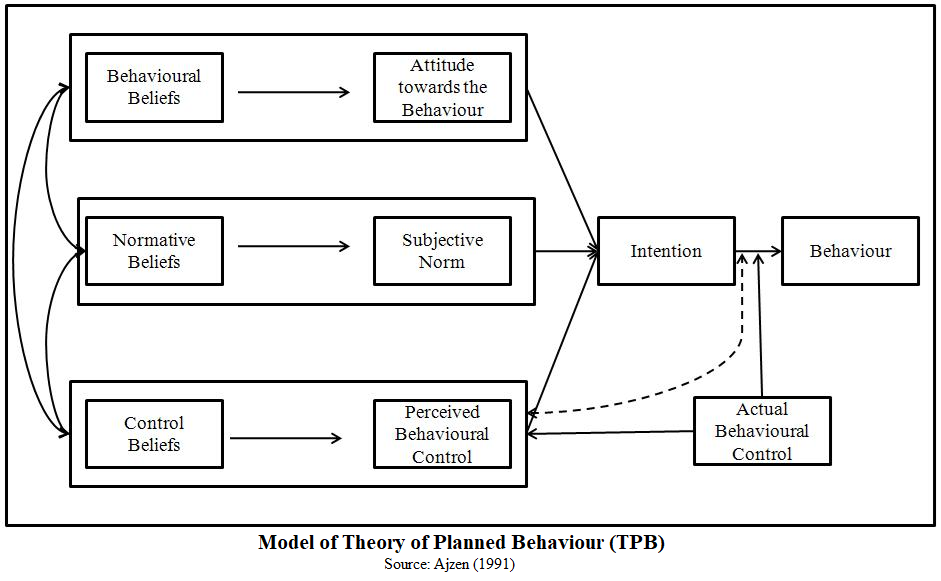Theory of Planned Behaviour- Comprehensive notes
The Theory of Planned Behaviour (TPB) is an extension of the theory of reason action (TRA) (Ajzen & Fishbein, 1980). The TPB differs from the TRA in presence of perceived behavioural control (PBC). The TPB model seeks to predict behaviour over which persons have incomplete control by examining PBC. The TPB is one of the most influential conceptual frameworks for studying human action and it is widely used for a variety of topics (Ajzen, 2002). The theory is designed to explain and predict behaviour in a specific context.
A central factor in this theory is an intention to perform certain behaviour. In accordance with this approach, the intention captures motivational factors that influence behaviour. The motivational factors are indications of how much effort are people planning to exert, how much are willing to try in order to perform behaviour. There is a general rule and the stronger the intention to engage in behaviour, the more likely should be its performance (Ajzen, 1991).
Based on the TPB, human behaviour is guided by three kinds of considerations namely beliefs about the consequences of the behaviour (behavioural beliefs), beliefs about the normative expectations of other people (normative beliefs), and beliefs about the presence of factors that hinder performance of the behaviour (control beliefs). On this basis, behavioural beliefs produce favourable or unfavourable “attitudes towards behaviour”.
The “subjective norms” is drive from normative beliefs in perceived social pressure. Third kind of beliefs, control beliefs, give rise to PBC, which means ease or difficulty of performing particular behaviour. These three variables form the behavioural intention of people. The intention to perform behaviour is assumed to be immediate antecedent of behaviour. The TPB model is depicted in Figure below.

The first variable of the TPB model is “attitudes towards behaviour”. It refers to the degree to which an individual has a favourable or unfavourable evaluation or appraisal of the behaviour in question (Ajzen, 1991). The theory proposed that behavioural beliefs produce attitudes towards behaviour. Therefore, each belief links the behaviour to a certain outcome or to some other attribute such as the cost incurred by exerting behaviour. Attributes that are linked to particular behaviour are already valued positively or negatively. Thus, persons favour behaviour that they believe have desirable consequences and form unfavourable attitudes toward behaviour they associate with undesirable consequences (Ajzen, 1991).
“Subjective Norms” are second predictor of behaviour. This variable refers to a perceived social pressure to perform or not to perform the behaviour. It is assumed that important referent individuals or groups approve or disapprove certain behaviour (Ajzen, 1991). The different referents involved in the subjective norms can be family, friends, political parties, religious organizations, etc. It is assumed that socially worthy acts bring internally generated feelings of self-respect or pride. On the other hand, failure in socially worthy acts may invoke feelings of shame or self-reproach (Kalafatis, Pollard, East, & Tsogas, 1999).
Third variable playing important role in predicting behaviour is “perceived behavioural control”. PBC refers to the ease or difficulty of performing the behaviour and it reflects past experience as well as anticipated impediments and obstacles (Ajzen, 2002). Among beliefs that determine intention and action there is a set that deals with presence or absence of requisite resources and opportunities. These beliefs can be based on the past experience with the behaviour, but also on second-hand information about behaviour from reference, and by other factors contributing to the perceived difficulty of performing the behaviour in question. According to the TPB, the more resources and opportunities individuals believe they have, and fewer obstacles they anticipate, the greater should be their perceived control over the behaviour (Ajzen, 1991).
Reference:
Ajzen, I. (1991). The Theory of Planned Behavior. Organizational Behavior and Human Decision Processes 50, 179-211.
Ajzen, I. (2002). Perceived Behavioral Control, Self-Efficacy, Locus of Control, and the Theory of Planned Behavior Behaviour. Journal of Applied Social Psychology, 32(4),665-683.
Ajzen, I., & Fishbein, M. (1980).Understanding Attitudes and Predicting Social Behavior. Englewood Cliffs, NJ: Prentice Hall
Kalafatis, S., Pollard, M., East, R., & Tsogas, M. (1999). Green Marketing and Ajzen’s Theory of Planned Behaviour: A Cross-market Examination. Journal of Consumer Marketing,16(5), 441-460.
#Education for ALL